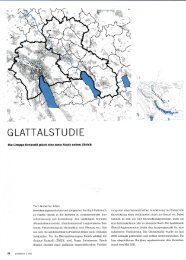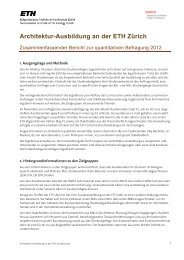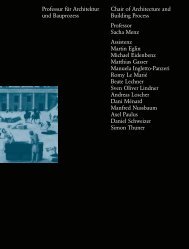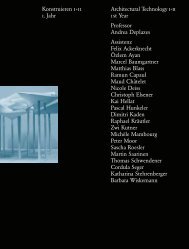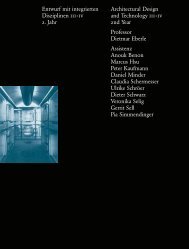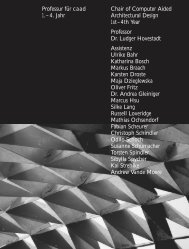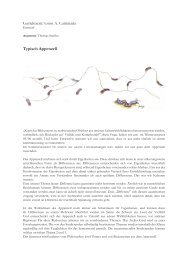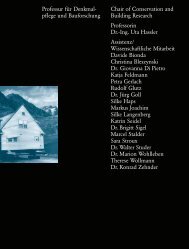Jahrbuch PDF (63MB) - ETH Zurich - ETH Zürich
Jahrbuch PDF (63MB) - ETH Zurich - ETH Zürich
Jahrbuch PDF (63MB) - ETH Zurich - ETH Zürich
Sie wollen auch ein ePaper? Erhöhen Sie die Reichweite Ihrer Titel.
YUMPU macht aus Druck-PDFs automatisch weboptimierte ePaper, die Google liebt.
Andreas Tönnesmann<br />
Einführung Departement Architektur<br />
Prof. Dr. Andreas<br />
Tönnesmann<br />
Qualität in der Architektur –<br />
und im Architekturunterricht<br />
Glück und Unglück der Aufmerksamkeit<br />
Architekten haben eigentlich nicht zu klagen: Kaum eine<br />
Disziplin der Natur-, Ingenieur- oder Geisteswissenschaften<br />
steht derzeit so unbestritten im Zentrum öffentlicher<br />
Aufmerksamkeit wie die Architektur. Gewiss, Nährboden<br />
des allgegenwärtigen Interesses an der baulichen<br />
Gestaltung der Umwelt ist oft genug Kritik: selten am zugrundeliegenden<br />
Konzept, um so häufiger dagegen am<br />
sichtbaren Resultat architektonischen Handelns. Architektur<br />
setzt zwar immer einen komplexen schöpferischen<br />
Prozess voraus, und alles Gebaute verweist insofern<br />
zurück in die Genese von Entwurf und Planung. Aber die<br />
Rezeption von Architektur, erst recht das negative Urteil,<br />
begnügt sich meist mit oberflächlicher Wahrnehmung:<br />
Fehlgeschlagene städtebauliche Experimente sind ebenso<br />
Anlass für Architektenschelte wie das eine oder andere<br />
prominente Gebäude, das von Publikum und Presse nach<br />
kurzem Hinsehen als misslungen eingestuft, als zu teuer<br />
erachtet, für elitär gehalten oder schlicht als überflüssig<br />
deklariert wird. Architektinnen und Architekten empfinden<br />
die fehlende fachliche Fundierung öffentlicher Kritik<br />
oft als Ärgernis. Sie vergessen dabei, dass ihr professionelles<br />
Tun den Menschen seit jeher unmittelbar betrifft und<br />
deshalb auch mit unmittelbaren Reaktionen rechnen muss:<br />
Architektur gehört der Sache nach zu den Themen,<br />
bei denen jeder mitreden möchte, gleich ob er über die<br />
Qualifikation dafür verfügt oder nicht.<br />
Die Forderung, sich weiten Teilen der Gesellschaft verständlich<br />
zu machen, darf man als Architekt deshalb<br />
nicht einfach beiseite schieben – im Gegenteil, dem Impetus<br />
der Verständlichkeit war und bleibt die Architektur im<br />
Unterschied zu den klassischen Wissenschaften immer verpflichtet.<br />
Und zur Verständlichkeit zu erziehen, gehört<br />
gerade heute zu den wichtigsten Aufgaben von Architekturschulen.<br />
Anders als Physiker oder Historiker operiert<br />
der Architekt in einem Handlungsfeld, das auf komplexe<br />
Begründungen und wissenschaftliche Methodik nicht<br />
verzichten kann, zugleich aber die Forderung stellt, dass<br />
sich die Ergebnisse auch jenseits weiterführender Erläuterungen,<br />
allein aus der Anschauung heraus, beurteilen<br />
lassen müssen. Prüfstein architektonischen Handelns<br />
bleibt das praktisch erzielte Resultat. Mit ihm muss sich<br />
der Architekt dem Publikum stellen, und zwar unter<br />
der erschwerenden Bedingung, dass die Reflexionstiefe des<br />
Entwurfs nur so weit Berücksichtigung findet, wie sie<br />
im Bauwerk selbst evident wird. Das intellektuelle Instrumentarium<br />
der Architektur – der Architektenkommentar,<br />
Quality in Architecture, and<br />
in Architectural Education<br />
The Fortune and Misfortune of Attentiveness<br />
Architects really have nothing to complain about: hardly<br />
any discipline in the natural, engineering, or human<br />
sciences has as indisputably been the focus of public<br />
attention as architecture. Certainly, the basis of general<br />
interest in the architectural design of the environment<br />
is, often enough, criticism: rarely of the underlying concept,<br />
but all the more commonly of the visible manifestation<br />
of architectural practice. Architecture always<br />
requires a complex creative process, thus everything that<br />
is built points back to the genesis of design and planning.<br />
Yet the reception of architecture, especially negative<br />
judgments, is typically confined to the superficial: the<br />
failure of urban planning experiments presents an occasion<br />
to chastise the architect just as this or that prominent<br />
building assessed fleetingly by the public and press and<br />
deemed a failure, or judged as being too expensive,<br />
elitist, or simply superfluous. Architects often experience<br />
irritation by public criticism that lacks any technical basis.<br />
In doing so, they forget that their professional activity<br />
has always has an immediate affect on people and that<br />
they must therefore expect immediate reactions:<br />
architecture is by nature one a subject in which everyone<br />
would like to have their say, whether or not they are<br />
qualified to do so.<br />
Architects may therefore not simply disregard the<br />
challenge of making themselves understood by the<br />
broader public – on the contrary, architecture in contrast<br />
to the classical sciences, has always been and is still<br />
obligated to make itself understood. Today, teaching how<br />
to impart ones ideas to the public counts among the<br />
most important tasks of architecture schools. Unlike the<br />
physicist or historian, the architect operates in a field<br />
to which complex justifications and scientific method are<br />
indispensable, yet simultaneously one that must accept<br />
the judgment of its results based simply on perception,<br />
without further explanations. The criteria on which<br />
architectural activity is judged, continues to be the results<br />
of its actual practice. This end result is how architects<br />
present themselves to the public, with the more complicating<br />
condition that the depth of reflection and thought<br />
put into a design is taken into account only in so far as<br />
it is evident in the building itself. This does not mean<br />
that the intellectual instruments available to architecture<br />
become superfluous – the architectural commentary,<br />
the analysis of a building, and the theoretical discussion –<br />
but they presumably play a greater role for the designer,<br />
to enrich and correct the creative process, than for<br />
the public who usually wants to form its judgment by<br />
looking, not reading.<br />
Fortunately, the general interest in architecture is often<br />
based on approval of, even enthusiasm for, architecture.<br />
Not only do outstanding architectural solutions deserve<br />
praise, but they also usually receive it. The commitment<br />
of both the private and public sectors of the economy<br />
8



